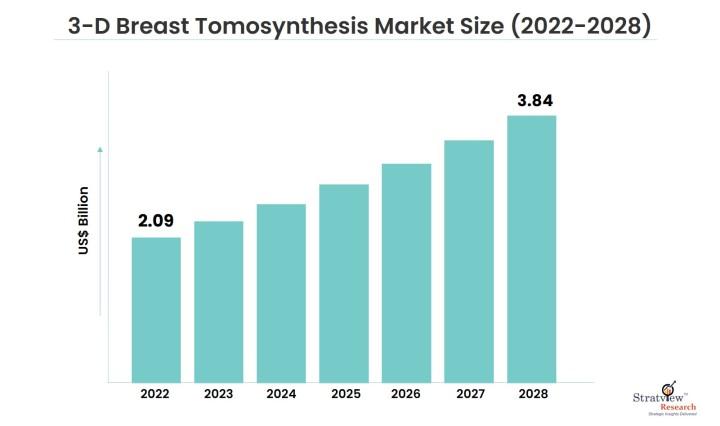Introduction:
Breast cancer remains a significant global health concern, driving constant innovation in diagnostic technologies. One such groundbreaking advancement is 3-D breast tomosynthesis, a sophisticated imaging technique that is reshaping the landscape of breast cancer detection. This article explores the current state, growth factors, challenges, and future prospects of the 3-D breast tomosynthesis market.
Understanding 3-D Breast Tomosynthesis:
3-D breast tomosynthesis, often referred to as 3DBT or digital breast tomosynthesis (DBT), is an advanced imaging modality that provides a three-dimensional reconstruction of the breast. Unlike traditional 2-D mammography, tomosynthesis captures multiple images from different angles, offering a more detailed and comprehensive view of breast tissue. This enhanced imaging capability has proven instrumental in improving the accuracy of breast cancer diagnosis.
The Global 3-D Breast Tomosynthesis Market is estimated to grow from USD 2.09 billion in 2022 to USD 3.84 billion by 2028 at a CAGR of 10.6% during the forecast period.
Read more: https://www.stratviewresearch.com/Request-Sample/1679/3-D-breast-tomosynthesis-market.html#form
Market Growth Drivers:
Several factors contribute to the exponential growth of the 3-D breast tomosynthesis market:
Improved Diagnostic Accuracy: 3DBT enhances the ability to detect lesions and abnormalities, reducing false positives and negatives compared to traditional mammography.
Rising Breast Cancer Incidence: With a global increase in breast cancer cases, there is a growing demand for advanced diagnostic tools that can facilitate early detection and improve patient outcomes.
Technological Advancements: Ongoing innovations in imaging technology, including improved resolution and faster image acquisition, are driving market growth.
Clinical Adoption: The medical community's increasing acceptance and incorporation of 3-D breast tomosynthesis into routine screening and diagnostic practices contribute to market expansion.
Challenges in the Market:
While the 3-D breast tomosynthesis market experiences substantial growth, it also faces certain challenges:
Cost Barriers: The initial costs associated with implementing 3DBT systems can be a barrier to adoption for some healthcare facilities.
Training and Education: Proper training for radiologists and healthcare professionals is crucial for effective utilization of 3-D breast tomosynthesis technology.
Regulatory Compliance: Stringent regulatory requirements and standards must be met, posing challenges for manufacturers and healthcare providers.
Future Prospects:
The future of the 3-D breast tomosynthesis market looks promising, with ongoing developments and advancements:
Integration with AI: Artificial intelligence (AI) is likely to play a significant role in image interpretation, aiding radiologists in faster and more accurate diagnoses.
Global Access: Efforts to make 3-D breast tomosynthesis more accessible, particularly in developing regions, are expected to drive market growth.
Research and Development: Continued research and development initiatives will focus on refining imaging technologies, reducing costs, and expanding applications in breast health.
Conclusion:
As we celebrate the one-year anniversary of the introduction of this article, the 3-D breast tomosynthesis market continues to evolve, offering new hope in the fight against breast cancer. With ongoing technological advancements and increasing clinical adoption, this revolutionary imaging modality is set to become a cornerstone in the early detection and diagnosis of breast cancer, ultimately contributing to improved patient outcomes worldwide.
